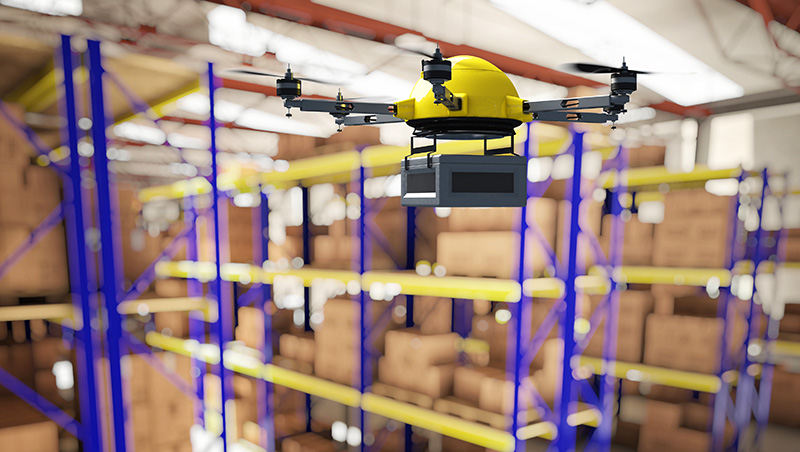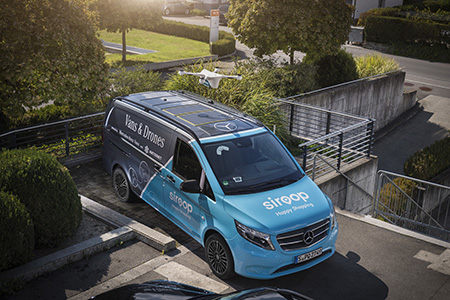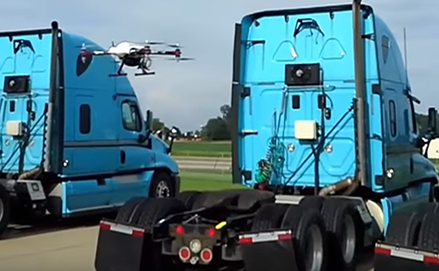 As global giants like Amazon continue to assess the viability of using unmanned aerial vehicles for deliveries, companies around the world are becoming ever more interested in the potential of drones. Aside from making consumer deliveries, drone technology has already emerged as an active area of research and development in the broader automotive industry. Attention has tended to focus so far on potential applications in the supply chain during vehicle assembly, whether in monitoring parts and vehicle locations or even moving parts around factories. But there is also interest in aftermarket commercial applications, where the drone interacts with the vehicle to sense the environment.
As global giants like Amazon continue to assess the viability of using unmanned aerial vehicles for deliveries, companies around the world are becoming ever more interested in the potential of drones. Aside from making consumer deliveries, drone technology has already emerged as an active area of research and development in the broader automotive industry. Attention has tended to focus so far on potential applications in the supply chain during vehicle assembly, whether in monitoring parts and vehicle locations or even moving parts around factories. But there is also interest in aftermarket commercial applications, where the drone interacts with the vehicle to sense the environment.
According to Rahul Bhattacharyya, director of sensor technology architecture and application at logistics technology specialists Surgere, a lot of the discussion relating to the use of drones in the automotive supply chain now centres on inventory control. He suggests RFID readers deployed on drones, for example, could be used to automatically conduct periodic surveys of finished vehicle inventory in open parking lots near manufacturing plants. Similarly, drones fitted with RFID or barcode scanners could automatically conduct stock checks in a warehouse. And they might even be used to replenish those stocks, he adds.
“Taken a step further, drones could carry replenishment parts to specified locations in the warehouse once a lack of inventory has been confirmed,” he says. “Most of the advantages of using drones centre around automation, environmental sensing and 3D situational awareness, as well as convenience, safety and extending the reach of delivery or survey vehicles.”
Besides inventory control, Bhattacharyya also highlights potential aftermarket applications, which could follow examples in the business-to-consumer field. One such, which he says is being actively considered by Mercedes-Benz, UPS and DHL, is the use of drones on delivery vans to extend the reach of the vehicle; for example, delivering packages to the balcony of a higher floor apartment.
In the autumn, Mercedes-Benz completed a trial using two vans complemented by drones to carry out deliveries in Zurich, Switzerland, to customers who placed orders on Swiss online shopping platform Siroop. Around 100 flights were made without any issues and more are planned for 2018.

William Wappler, president and chief executive at Surgere, says his company has also investigated the use of drones for data acquisition at various points along a digitalised supply chain, something he says has “tremendous” potential.
“However, today, with governmental administrative regulations and other commercial restrictions relating to insurance, operational health and safety interpretations and client legal risk, among others, we proceeded with ground-based wheeled and legged robotics,” he says.
Regulations vary not only by country, but also in different locations. In Germany, as well as outdoor limits, there are restrictions over the use of drones indoors, which has made their use in factories and warehouses more complicated. In the US, the Trump administration has recently made moves to improve drone legislation by calling for the creation of innovation zones that would loosen federal aviation rules to allow drone tests and deliveries. However, it is unclear how these zones and operations will be determined at local levels. Many companies are still waiting to see how laws develop.
“When the regulatory environment becomes friendly, the true potential becomes realised within the technology, and the opportunity to return a reasonable ROI and level of positive operations impact that we expect to deliver to our clients [is there], we’ll incorporate drones into our overall mix of data collection tools,” says Wappler.
Visual recognitionSrini Muthusrinivasan, senior industry strategies director at JDA Software, says most companies interested in drone technology are currently limiting their activities to applications based on visual recognition – such as counting trailers in a yard, or cycle counting in parts warehouses to check on inventory. In the future, however, he predicts drones will be used to speed up shipments, in the process helping to compress lead times for both ordering and distribution.
“It’s important to remember that we aren’t there yet, but the good news is that the application of drone technology is bound to skyrocket over the next five years, both within the automotive OEM and aftermarket ecosystem, as well as in wider industrial areas,” he says.
While the use of drones is still a new development for the automotive logistics industry, Muthusrinivasan says JDA is currently in the process of “interacting and collaborating” around the concept with several 3PLs. From discussions to date, he envisages that the deployment of drones will take two distinct forms. To begin with, he says, drones could, by themselves, be considered as a fleet or resource. And secondly, he suggests, they have a role to play in data collection.
"It’s important to remember that we aren’t there yet, but the good news is that the application of drone technology is bound to skyrocket over the next five years, both within the automotive OEM and aftermarket ecosystem, as well as in wider industrial areas." - Srini Muthusrinivasan, JDA Software
“Once drones are ready in the marketplace, subject to governance, air traffic control approvals and so on, we could help manage the constraints and work effectively within the rules. Secondly, JDA is enabling digital supply chains by being able to sense and respond to the live signals that come from various devices and apps that provide information for certain systems – a drone could be one such device,” he explains.
Real-time locationRafael Granato, marketing director at industrial drone supplier PINC, points out that another potential application of drones in automotive logistics is to use them as part of broader real-time location systems (RTLS), a general area of technology that determines the current position of an object based on real-time information gathered through a wireless system of some sort.
Ever since the adoption of global positioning system (GPS) satellites for vehicle navigation, various techniques have been developed and introduced to the market for tracking people, inventory and other assets in applications spanning healthcare, security, safety and logistics. According to Granato, the common challenge RTLS seeks to address is the need for “time-sensitive, location-related information and accuracy, often brought about due to the dynamic nature of the object being tracked”.
“For automotive logistics applications, increasing demand for real-time visibility in today’s globalised supply chain means RTLS is becoming an indispensable element for technology investments aiming to improve the visibility of data critical for management to make informed and effective budgeting, operating and financial decisions,” he says.
That said, Granato believes mobile asset tracking in yards or lots presents an interesting application for RTLS because the environment, while outdoors, is still a contained physical space.
Until recently, he explains, the most prevalent approach to managing trailers, vehicles and other high-value assets in the yard has been to depend on all-manual, resource-intensive processes to track their location and status, often leaving the integrity of data compromised due to human error and the non-real-time nature of such processes.
[mpu_ad]He also points out that GPS and cellular-based systems are no longer viable for indoor inventory tracking in factories and warehouses because of the lack of sufficient signal strengths to provide satisfactory precision.
Most leading-edge organisations use more than one counting approach to keep track of inventory inside warehouses, contends Granato. Although sometimes effective, he suggests such approaches have their drawbacks, mainly because the process is handled by error-prone people and can be disruptive to existing operations – possibly requiring a shut-down in normal operations or the use of additional temporary staff to complete in a restricted timeframe. Such approaches can also be unsafe, he suggests, if they require staff to work at height or move around otherwise dangerous and dispersed areas.
That’s why some companies are now considering the use of drones, coupled with advanced sensor capabilities like passive RFID, optical capabilities and barcode technology, to improve the operational effectiveness and efficiency of inventory checks in yards, lots, and warehouses, says Granato.
“Elevating the sensor platform into the air with the use of an autonomous unmanned aerial system enables automatic, accurate, efficient and safe inventory checks in hard-to-reach locations,” he stresses. Such drones are also able to identify, locate and reconcile inventory information faster and more accurately than a human can, he adds.
Tracking finished vehiclesThere are some indications that drones could also be useful for tracking finished vehicles in storage and at various transit points in the distribution chain.
According to Hartmut Haubrich, director of finished vehicle logistics systems at Inform Software, drone technology could be used to quickly scan large areas automatically or semi-automatically, and certainly where remote identification of items is possible. However, he stresses, such applications depend heavily on the information needed and the environment.
Swiss logistics services provider Kuehne + Nagel (KN) is currently carrying out a project focused on the deployment of drones equipped with on-board cameras to conduct more rapid inventory checks and counts. Achim Glass, head of global automotive vertical, presented the pilot at the recent Automotive Logistics UK summit.
The key objective of the project, dubbed InventAIRy, is to enable fully autonomous inventory checks by using camera carrying drones to fly around warehouses and capture images of pallet racking. Dedicated software is then used to compare the product barcode and storage location information captured by the drone to the data held by a company’s warehouse management system (WMS) in an effort to identify any gaps.
Glass said the main benefit to potential customers was the ability to carry out an expedited inventory count using less manpower, ultimately helping to improve the bottom line. Other, as yet untested benefits cited by the company include improved capacity to assess stock occupation and overall volume levels, as well as to check the optimal pallet location height and identify damage.
Audi has also been looking into the use of drones, in particular carrying out a trial to test their potential for parts deliveries. It says the results have been largely positive but that it will not be pursuing the use of the technology for now as drones cannot handle heavier parts and current regulations in Germany do not allow their use in closed environments like a production hall.
Haubrich predicts that security applications could also become “a significant area of application” – for example, using drones equipped with thermal imaging cameras.
“This can go together with computing, where a local but still powerful computer performs tasks like image processing and sends the results as soon as a wireless connection is available,” he says, noting that Intel recently proposed this idea.
“In finished vehicle logistics, more and more vehicles will have the ability to send their GPS position. This can also be retrofitted to vehicles by using GPS dongles on an OBD [on-board device] connector. We see this vehicle-based GPS as the technology of the future in the field of finished vehicle logistics,” he adds.
Sector interest levelsRahul Bhattacharyya stresses that defence remains far ahead of any other sector in investment into and deployment of drone technology, with civilian applications like infrastructure condition monitoring and agriculture also showing a good deal of growth potential.
“This makes sense as there is strong appeal for drones to remotely and autonomously monitor large areas of buildings, transportation networks and crops,” he says.
“Automotive and transportation has billion-dollar market potential and as a result, companies like Ford are investing heavily in building software infrastructure for connected vehicles that allows your phone and home assistants, like [Amazon’s] Alexa and Google Home, to synchronise with the vehicle. In addition, they could also take input from companion drones to provide situational awareness around the vehicle,” he adds.
Hartmut Haubrich argues those industries that operate indoors, in particular those running warehouse facilities, will emerge as front-runners for the take-up of drones. Srini Muthusrinivasan, however, stresses that most commercial industries have yet to adopt drones in a big way and adds: “The delivery piece of the puzzle is where we are likely to see growth in the use of drones over the next few years.”
[related_topics align="right" border="yes"]In the near term, he suggests, we are likely to see drones carrying out freight delivery to inaccessible terrains, as well as what he describes as “mission-critical deliveries tied to life sciences and last-mile B2C and B2Me door deliveries”.
“Over the long term, bigger developments that could be driven by drones could include the transportation of commercial passengers and bulk weight shipments, and – wider than that – tourism,” he suggests.
Granato envisages that drones will soon feature autonomous sensing and object avoidance technology, enabling them to “fly around yards and warehouses 24/7 with no need for human interaction, capturing accurate visual, status, location and count information and sharing this information in real time with other applications”.
“Dealers will also use drones to find assets in dealerships and provide a better experience for the end customer,” he predicts.
 Drones could be used to track vehicles which can even be retrofitted with GPS dongles to provide location information
Drones could be used to track vehicles which can even be retrofitted with GPS dongles to provide location informationPINC is currently working with customers from all segments, including automotive, that are trying to solve inventory accuracy, identification and location challenges, inside and outside of plants and warehouses, he adds.
“We certainly see a huge appetite from the automotive industry to gain real-time visibility inside and outside of their facilities,” he confirms. “It all comes down to knowing where inventory is and to collecting, mapping and timestamping every step of the process so information can be analysed to make sure the entire lifecycle is optimised, products are delivered on time, demand can be predicted and adjusted and, most importantly, customers are kept happy.”





















